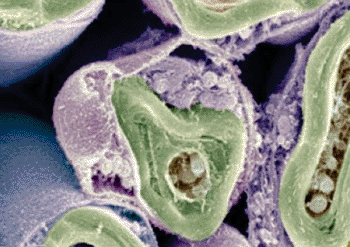Control of Neuropathic Pain Depends on a Schwann Cell Protein
By LabMedica International staff writers
Posted on 09 Apr 2013
Pain researchers have found that a protein produced by Schwann cells plays a critical role in controlling allodynia (painful response to a stimulus that does not normally elicit pain) and in regulating the recovery of peripheral nerves after injury.Posted on 09 Apr 2013
Schwann cells are involved in many important aspects of peripheral nerve biology such as the conduction of nervous impulses along axons, nerve development and regeneration, trophic support for neurons, production of the nerve extracellular matrix, modulation of neuromuscular synaptic activity, and presentation of antigens to T-lymphocytes.

Image: Schwann cells (colored purple) forming myelin sheathes (green) around axons (brown) (photo courtesy of David Furness, Wellcome Images).
Investigators at the University of California, San Diego (UCSD; USA) recently linked the protein LRP1 (LDL receptor-related protein-1) produced by Schwann cells to the neuropathic pain that occurs when peripheral nerve fibers are damaged or become dysfunctional. LRP1 is an endocytic receptor involved in several cellular processes, including intracellular signaling, lipid homeostasis, and clearance of apoptotic cells. In addition, the encoded protein is necessary for the clearance of secreted amyloid precursor protein and beta-amyloid, the main component of amyloid plaques found in Alzheimer's disease patients. Expression of the LRP1 gene decreases with age and has been found to be lower than controls in brain tissue from Alzheimer patients.
For this study, the investigators genetically engineered a line of mice lacking the gene for production of LRP1. They reported in the March 27, 2013, issue of the Journal of Neuroscience that these mice had abnormalities in axon myelination and in ensheathment of axons by nonmyelinating Schwann cells in Remak bundles (multiple nonmyelinated pain transmitting axons grouped together by Schwann cells). Remyelinated axons were evident 20 days after crush injury in control mice, yet were largely absent in mice lacking the LRP1 gene. In the partial nerve ligation model, mice without LRP1 demonstrated significantly increased and sustained mechanical allodynia and loss of motor function.
These studies identified LRP1 as an essential mediator of normal Schwann cell activity and as a pivotal regulator of the Schwann cell response to peripheral nervous system injury in vivo. "LRP1 helps mediate normal interactions between Schwann cells and axons and, when peripheral nerves have been injured, plays a critical role in regulating the steps that lead to eventual nerve regeneration," said senior author Dr. Wendy Campana, associate professor of anesthesiology at the University of California, San Diego. "When LRP1 is deficient, defects and problems become worse. They may go from acute to chronic, with increasing levels of pain."
The investigators are working to develop small molecule drugs to mimic LRP1 binding to receptors in Schwann cells to improve their health and ability to repair damaged nerve cells. "By targeting Schwann cells and LRP1, I think we can improve cells' response to injury, including reducing or eliminating chronic neuropathic pain," said Dr. Campana.
Related Links:
University of California, San Diego














